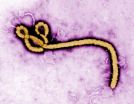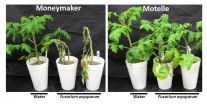(Press-News.org) BUFFALO, N.Y. — A new study is helping to rewrite Ebola's family history.
The research shows that filoviruses — a family to which Ebola and its similarly lethal relative, Marburg, belong — are at least 16-23 million years old.
Filoviruses likely existed in the Miocene Epoch, and at that time, the evolutionary lines leading to Ebola and Marburg had already diverged, the study concludes.
The research was published in the journal PeerJ in September. It adds to scientists' developing knowledge about known filoviruses, which experts once believed came into being some 10,000 years ago, coinciding with the rise of agriculture. The new study pushes back the family's age to the time when great apes arose.
"Filoviruses are far more ancient than previously thought," says lead researcher Derek Taylor, PhD, a University at Buffalo professor of biological sciences. "These things have been interacting with mammals for a long time, several million years."
According to the PeerJ article, knowing more about Ebola and Marburg's comparative evolution could "affect design of vaccines and programs that identify emerging pathogens."
The research does not address the age of the modern-day Ebolavirus. Instead, it shows that Ebola and Marburg are each members of ancient evolutionary lines, and that these two viruses last shared a common ancestor sometime prior to 16-23 million years ago.
Clues in 'fossil genes'
Taylor and co-author Jeremy Bruenn, PhD, UB professor of biological sciences, research viral "fossil genes" — chunks of genetic material that animals and other organisms acquire from viruses during infection.
In the new study, the authors report finding remnants of filovirus-like genes in various rodents. One fossil gene, called VP35, appeared in the same spot in the genomes of four different rodent species: two hamsters and two voles. This meant the material was likely acquired in or before the Miocene Epoch, prior to when these rodents evolved into distinct species some 16-23 million years ago.
In other words: It appears that the known filovirus family is at least as old as the common ancestor of hamsters and voles.
"These rodents have billions of base pairs in their genomes, so the odds of a viral gene inserting itself at the same position in different species at different times are very small," Taylor says. "It's likely that the insertion was present in the common ancestor of these rodents."
The genetic material in the VP35 fossil was more closely related to Ebola than to Marburg, indicating that the lines leading to these viruses had already begun diverging from each other in the Miocene.
The new study builds on Taylor's previous work with Bruenn and other biologists, which used viral fossil genes to estimate that the entire family of filoviruses was more than 10 million years old. However, those studies used fossil genes only distantly related to Ebola and Marburg, which prevented the researchers from drawing conclusions about the age of these two viral lines.
The current PeerJ publication fills this viral "fossil gap," enabling the scientists to explore Ebola's historical relationship with Marburg.
Possible relevance to disease prevention
The first Ebola outbreak in humans occurred in 1976, and scientists still know little about the virus' history. The same dearth of information applies to Marburg, which was recognized in humans in 1967 and implicated in the death of a Ugandan health worker this month.
Understanding the virus' ancient past could aid in disease prevention, Taylor says. He notes that if a researcher were trying to create a single vaccine effective against both Ebola and Marburg, it could be helpful to know that their evolutionary lineages diverged so long ago.
Knowing more about filoviruses in general could provide insight into which host species might serve as "reservoirs" that harbor undiscovered pathogens related to Ebola and Marburg, Taylor says.
"When they first started looking for reservoirs for Ebola, they were crashing through the rainforest, looking at everything — mammals, insects, other organisms," Taylor says. "The more we know about the evolution of filovirus-host interactions, the more we can learn about who the players might be in the system."
INFORMATION:
Collaborators
Taylor and Bruenn's co-authors on the PeerJ study include UB students Matthew Ballinger, Laura Hanzly and Jack Zhan, all in the UB Department of Biological Sciences.
Adherent cells, the kind that form the architecture of all multi-cellular organisms, are mechanically engineered with precise forces that allow them to move around and stick to things. Proteins called integrin receptors act like little hands and feet to pull these cells across a surface or to anchor them in place. When groups of these cells are put into a petri dish with a variety of substrates they can sense the differences in the surfaces and they will "crawl" toward the stiffest one they can find.
Now chemists have devised a method using DNA-based tension probes to ...
Tempe, Ariz. (Oct. 23, 2014) - New research findings from a team of prevention scientists at Arizona State University demonstrates that a family-focused intervention program for middle-school Mexican American children leads to fewer drop-out rates and lower rates of alcohol and illegal drug use.
"This is the first randomized prevention trial that we're aware of to show effects on school dropout for this population," said Nancy Gonzales, Foundation Professor in the REACH Institute and Psychology Department, College of Liberal Arts and Sciences at Arizona State University. ...
RIVERSIDE, Calif. – Plant breeders have long identified and cultivated disease-resistant varieties. A research team at the University of California, Riverside has now revealed a new molecular mechanism for resistance and susceptibility to a common fungus that causes wilt in susceptible tomato plants.
Study results appeared Oct. 16 in PLOS Pathogens.
Katherine Borkovich, a professor of plant pathology and the chair of the Department of Plant Pathology and Microbiology, and colleagues started with two closely related tomato cultivars: "Moneymaker" is susceptible ...
ORLANDO, Fla. – New research shows obese children with asthma may mistake symptoms of breathlessness for loss of asthma control leading to high and unnecessary use of rescue medications. The study was published online in the Journal of Allergy and Clinical Immunology (JACI), the official scientific journal of the American Association of Allergy, Asthma and Immunology.
"Obese children with asthma need to develop a greater understanding of the distinct feeling of breathlessness in order to avoid not just unnecessary medication use, but also the anxiety, reduced quality ...
Just three years ago, a patient at Sahlgrenska University Hospital received a blood vessel transplant grown from her own stem cells.
Suchitra Sumitran-Holgersson, Professor of Transplantation Biology at The Univerisity of Gothenburg, and Michael Olausson, Surgeon/Medical Director of the Transplant Center and Professor at Sahlgrenska Academy, came up with the idea, planned and carried out the procedure.
Missing a vein
Professors Sumitran-Holgersson and Olausson have published a new study in EBioMedicine based on two other transplants that were performed in 2012 at Sahlgrenska ...
Gossip is pervasive in our society, and our penchant for gossip can be found in most of our everyday conversations. Why are individuals interested in hearing gossip about others' achievements and failures? Researchers at the University of Groningen in the Netherlands studied the effect positive and negative gossip has on how the recipient evaluates him or herself. The study is published in Personality and Social Psychology Bulletin.
In spite of some positive consequences, gossip is typically seen as destructive and negative. However, hearing gossip may help individuals ...
New data shows that healthcare and personal costs to support survivors of stroke remains high 10 years on.
The Monash University research, published today in the journal Stroke, is the first to look at the long-term costs for the two main causes of stroke; ischemic where the blood supply stops due to a blood clot, and hemorrhagic, which occurs when a weakened blood vessel supplying the brain bursts.
Previous studies based on estimating the lifetime costs using patient data up to 5 years after a stroke, suggested that costs peaked in the first year and then declined ...
Metamaterials, a hot area of research today, are artificial materials engineered with resonant elements to display properties that are not found in natural materials. By organizing materials in a specific way, scientists can build materials with a negative refractivity, for example, which refract light at a reverse angle from normal materials. However, metamaterials up to now have harbored a significant downside. Unlike natural materials, they are two-dimensional and inherently anisotropic, meaning that they are designed to act in a certain direction. By contrast, three-dimensional ...
An unprecedented boom in hydropower dam construction is underway, primarily in developing countries and emerging economies. While this is expected to double the global electricity production from hydropower, it could reduce the number of our last remaining large free-flowing rivers by about 20% and pose a serious threat to freshwater biodiversity. A new database has been developed to support decision making on sustainable modes of electricity production. It is presented today at the international congress Global Challenges: Achieving Sustainability hosted by the University ...
October 24, 2014 – For patients with a severe type of stroke called subarachnoid hemorrhage (SAH), treatment at a hospital that treats a high volume of SAH cases is associated with a lower risk of death, reports a study in the November issue of Neurosurgery, official journal of the Congress of Neurological Surgeons. The journal is published by Lippincott Williams & Wilkins, a part of Wolters Kluwer Health.
After adjustment for other factors, the mortality rate after SAH is about one-fifth lower at high-volume hospitals, according to the report by Dr. Shyam Prabhakaran ...

